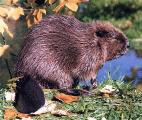
Adult beavers grow to 40 inches in length and weigh 40-60 pounds.The beaver's tail is trowel-shaped and is scaly with a leather-likecovering. While swimming, the beaver uses its tail for propelling itthrough the water.
The beaver's front feet are extremely dextrous with long, sharp claws suited for excavation and obtaining food. Beavers have mini thumbs that are weak and virtually useless. The little fingers oneach front paw have practically replaced the thumbs. The beaver's hind feet arewide and webbed between the toes. Along with the tail, the hind feetpropel the beaver through the water. The beaver has a unique feature to the hind feet: a split or double second claw.

Beavers have poor vision, but its sense of smell and hearing are acute.Beavers can stay submerged up to 15 minutes.
Male and female beavers have musk sacs or castors which produce an oily, smelly substance called castoreum. Commercially, castoreum is used in the production of perfumes and medicines.
The beaver's diet is all vegetable, therefore, it is a herbivore. Beavers prefer softferns, mushrooms, grasses, algae, roots, bark, and twigs to eat.

Like other rodents, beavers front teeth are continually growing. Thus, a beaver must always gnaw and cut on wood. Beavers can cut whole trees.
Beavers breed between February and March. It has been speculated that female beavers aremonogamous, but male beavers mate with more than 1 female. Following mating, the female drives herfamily out of the lodge and gives birth to 3 to 6 kits following a 12 week gestation period. Baby beavers nurse until they are 5 to 7 weeks old. Young remain with theirparents up to 2 years.
Usually 5 to 12 beavers (usually family) form a colony.